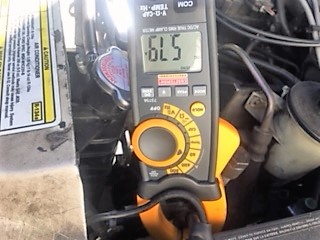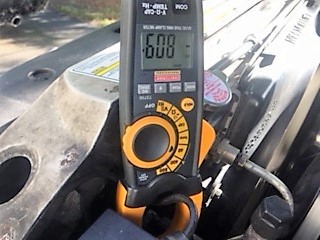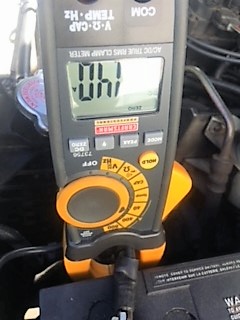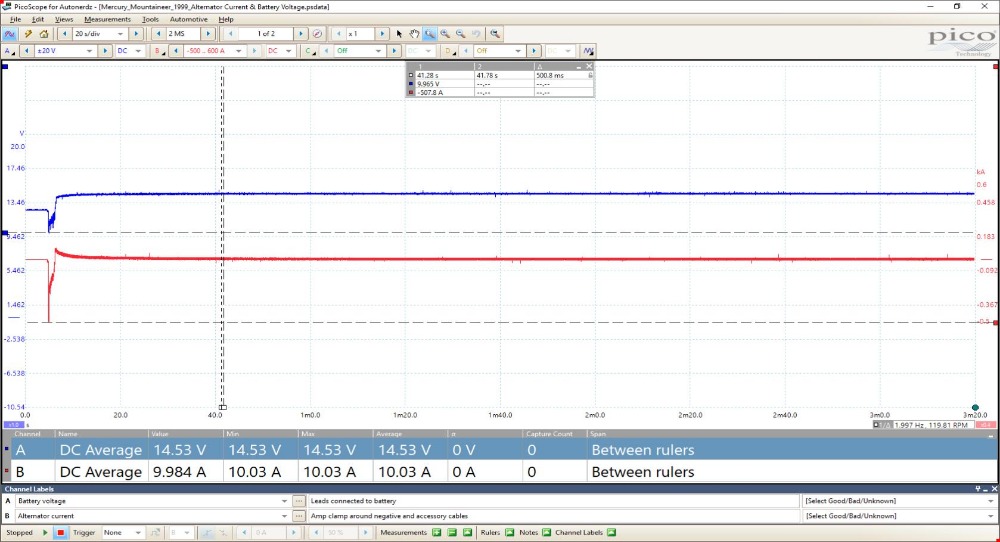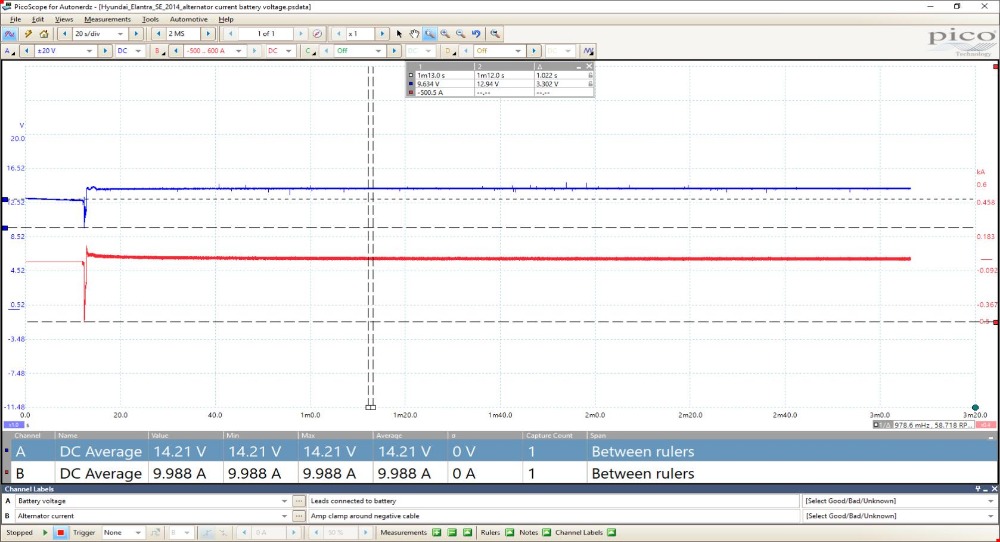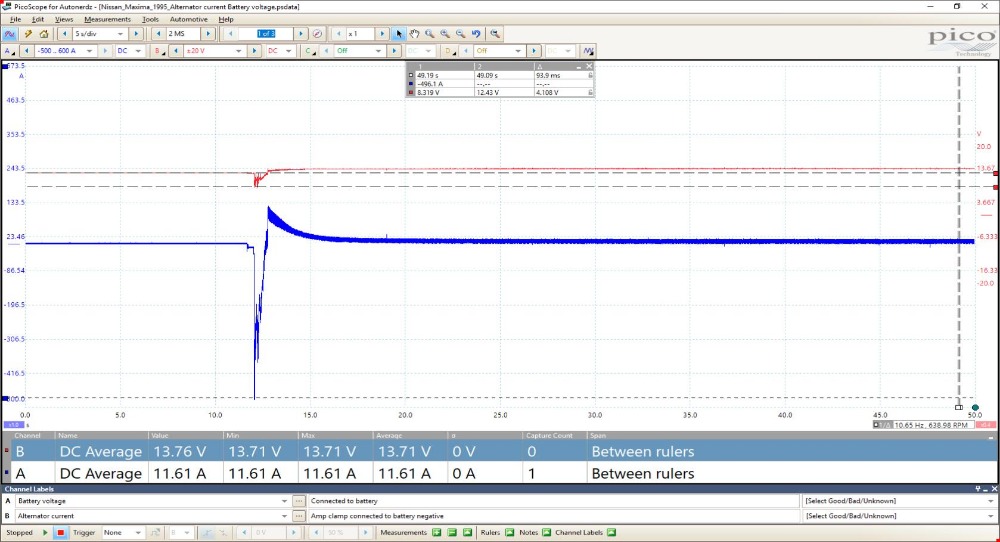A place to discuss hardware/software and diagnostic procedures
Alternator and Battery Testing with Pico
- Charles Acosta
-
Topic Author
- Offline
- Senior Member
-

Less
More
- Posts: 79
- Thank you received: 13
5 years 11 months ago - 5 years 11 months ago #21629
by Charles Acosta
Alternator and Battery Testing with Pico was created by Charles Acosta
Thanks to Andy for his thread on car battery basics i figure I chime in on how I test not only the battery but the alternator output. We all know that a battery that demands a lot from the alternator's output current constantly can burn it out. A battery can have a good cranking voltage to turn over the engine but if its weak in the recharge mode you'll eventually have a dead battery and a alternator with it.
An amp clamp is perfect to do your testing. The one i use the Pico automotive and a Craftsman with a LCD and a built in multimeter. When you connect it on the negative side of the battery you'll either come across a negative cable or a negative and a accessory cables. If its just a negative cable then its easy. But how do you check the alternator's output when there is a negative and a accessory cables connected to the battery? Lets say an amp clamp connected to the negative cable and your reading is 25 amps. Connected to accessory cable it reads 20 amps.In both instances they are high readings but connected around both wires and your reading is 5 amps because the clamp reads the difference between the two. With 5 amps you can say the battery recharge state is good and the alternator isn't working hard.
When the engine first starts the alternator current is high. What i look for is the current to go down under 10 amps within the first five minutes. It can take longer depending on weather and the state of the battery. Under 10 amps you're golden. in the teens keep a watchful eye. In the 20s and the alternator is working hard to keep that battery charged.
The clamp is connected to negative cable
To accessory cable
Clamp around both wires
Using the Pico on three cars
An amp clamp is perfect to do your testing. The one i use the Pico automotive and a Craftsman with a LCD and a built in multimeter. When you connect it on the negative side of the battery you'll either come across a negative cable or a negative and a accessory cables. If its just a negative cable then its easy. But how do you check the alternator's output when there is a negative and a accessory cables connected to the battery? Lets say an amp clamp connected to the negative cable and your reading is 25 amps. Connected to accessory cable it reads 20 amps.In both instances they are high readings but connected around both wires and your reading is 5 amps because the clamp reads the difference between the two. With 5 amps you can say the battery recharge state is good and the alternator isn't working hard.
When the engine first starts the alternator current is high. What i look for is the current to go down under 10 amps within the first five minutes. It can take longer depending on weather and the state of the battery. Under 10 amps you're golden. in the teens keep a watchful eye. In the 20s and the alternator is working hard to keep that battery charged.
The clamp is connected to negative cable
To accessory cable
Clamp around both wires
Using the Pico on three cars
Last edit: 5 years 11 months ago by Charles Acosta.
The following user(s) said Thank You: Andy.MacFadyen
Please Log in or Create an account to join the conversation.
- Andy.MacFadyen
-

- Offline
- Moderator
-

Less
More
- Posts: 3353
- Thank you received: 1032
5 years 11 months ago #21630
by Andy.MacFadyen
" We're trying to plug a hole in the universe, what are you doing ?. "
(Walter Bishop Fringe TV show)
Replied by Andy.MacFadyen on topic Alternator and Battery Testing with Pico
Classic  Good work the Pico test is a great way of doing it as it combines many tests in one and will show early signs of a failing battery long before other more traditional tests and you have a screen capture to shown the customer,
Good work the Pico test is a great way of doing it as it combines many tests in one and will show early signs of a failing battery long before other more traditional tests and you have a screen capture to shown the customer,
I have been using a cut down version of it simply connecting the scope to the cigar lighter socket B+ and capturing the start-up voltage.
I intend to look at battery charging and after that testing and will link into your thread
I have been using a cut down version of it simply connecting the scope to the cigar lighter socket B+ and capturing the start-up voltage.
I intend to look at battery charging and after that testing and will link into your thread
" We're trying to plug a hole in the universe, what are you doing ?. "
(Walter Bishop Fringe TV show)
The following user(s) said Thank You: Charles Acosta
Please Log in or Create an account to join the conversation.
Time to create page: 0.203 seconds

